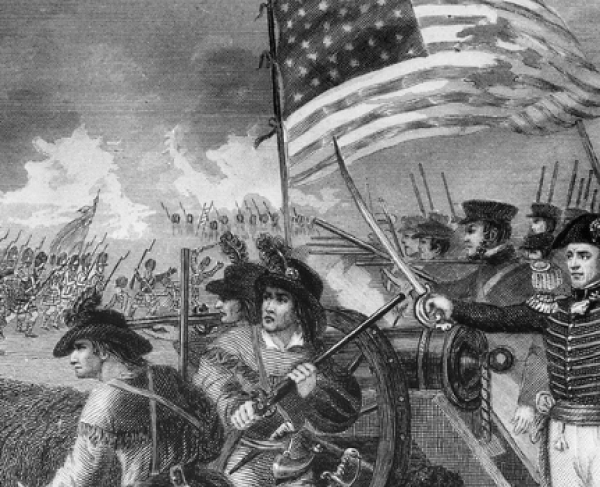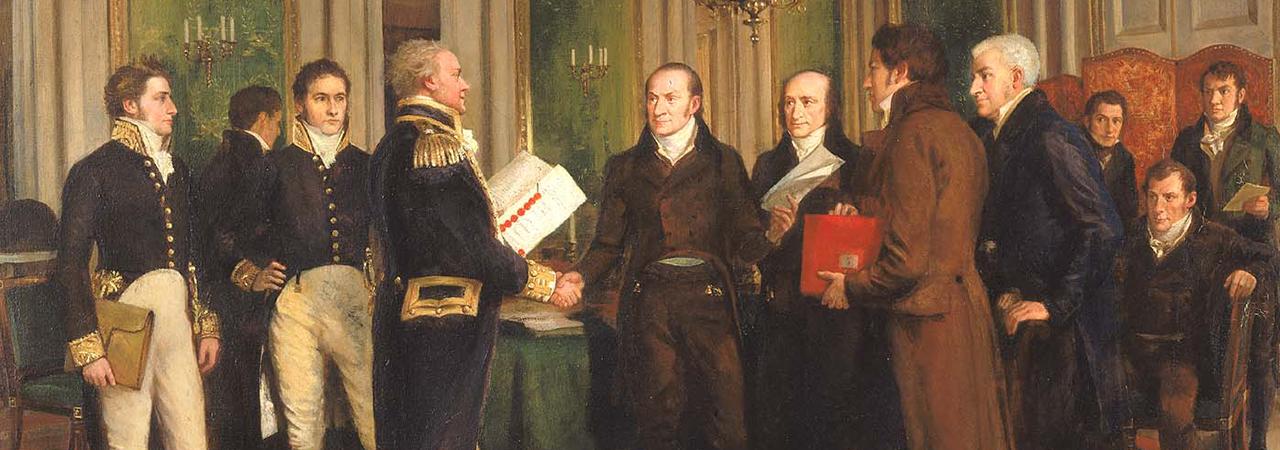
Sir Amédée Forestier, The Signing of the Treaty of Ghent, Christmas Eve, 1814, 1914, oil on canvas, Smithsonian American Art Museum, Gift of the Sulgrave Institution of the U.S. and Great Britain.
The War of 1812 is one of the least studied wars in American history. Sometimes referred to as the “Second War of Independence,” the War of 1812 was the first large scale test of the American republic on the world stage. With the British Navy impressing American sailors, and the British government aiding Native American tribes in their attacks on American citizens on the frontier, Congress, for the first time in our nation’s history, declared war on a foreign nation: Great Britain. The War of 1812 brought the United States onto the world's stage and was followed by a half-decade now called the "Era of Good Feelings."
This page offers answers to frequently asked questions about this formative and dramatic conflict. View the American Revolution and Civil War facts.
- When did the War of 1812 begin?
- When did the War of 1812 end?
- What were the causes of the War of 1812?
- What is impressment?
- Where was the War of 1812 fought?
- Who was the American President during the War of 1812?
- Who were some of the important military figures of the War of 1812?
- What role did Native Americans play in the War of 1812?
- What roles did African-Americans play in the War of 1812?
- How many people fought in the War of 1812?
- How many people died in the War of 1812?
- What were the major battles of the War of 1812?
- What kinds of weapons were used in the War of 1812?
- How advanced was medicine during the War of 1812?
- Were there any significant technological advancements during the War of 1812?
- What were the political effects of the War of 1812?
- What were the economic effects of the War of 1812?
- Who won the War of 1812?
- What are some of the best sources of information on the War of 1812?
- Are the War of 1812 battlefields preserved?
When did the War of 1812 begin?
The War of 1812 began on June 18th, 1812 with the Unites States formally declaring war on the United Kingdom. The war lasted from June 1812-February 1815, a span of two years and eight months.
When did the War of 1812 end?
Peace negotiations began in late 1814, but slow communication across the Atlantic (and indeed across the United States) prolonged the war and also led to numerous tactical errors for both sides. The Treaty of Ghent was signed by British and United States delegates on December 24th, 1814, to be enacted when each side formally ratified the treaty. The British were able to ratify the treaty on December 27th, but it took several weeks for the treaty to reach the United States. It was ratified by the US Senate on February 17th, 1815. The war lasted a total of two years and eight months.
What were the causes of the War of 1812?
The War of 1812 was part of a larger, global conflict. The empires of England and France spent 1789-1815 locked in an almost constant war for global superiority. That war stretched from Europe to North Africa and to Asia and, when the Americans declared war on England, the war engulfed North America as well.
The United States had a variety of grievances against Britain. Many felt that the British had not yet come to respect the United States as a legitimate country. The British were impressing, or American sailors at sea as well as blocking American trade with France—both of these were also spillover policies from the British prosecution of the war with France. The British were also unsubtly supporting Native American groups who were in conflict with American settlers along the frontier.
What is impressment?
Impressment was a practice wherein a nation would take men into military or naval forces by compulsion, without giving notice. Often referred to as the "press gang," impressment was used by several nations in the 19th century. The term is most commonly associated with the United Kingdom as it was a common practice for the Royal Navy to use impressment during wartime. Impressment was a grievance cited as a cause of the American Revolution but is most commonly associated with the War of 1812. The practice ceased in the Royal Navy after 1814.

Where was the War of 1812 fought?
The War of 1812 was fought in the United States, Canada, and on the high seas. Engagements were fought in the Old Southwest (Alabama, Louisiana, Georgia, and Mississippi), the Old Northwest (embracing Ohio, Illinois, Indiana, Michigan, Wisconsin) Canada, Coastal Maine and the Chesapeake.
Many battles were engaged in rivers, lakes, and the oceans. The British enforced a blockade of American ports, particularly in the South, along the Atlantic seaboard. Naval engagements flared, especially around the Chesapeake Bay, as this blockade was challenged. Additionally, since the war had a distinct commercial character, pirate-style raids were carried out against trade ships throughout the Atlantic. Lake Erie and Lake Ontario played major roles in the War of 1812. Sitting amidst the main theater of operations in the North, they shaped the movements of the contending armies. Large ships were built and put on the Lakes, where they engaged in full-scale battles for supremacy in order to move troops and bombard rival towns.
Who was the American President during the War of 1812?

James Madison, “the Father of the Constitution,” was the president throughout the war. When the nation was first founded, Madison was closely allied with Thomas Jefferson in seeking a decentralized agrarian democracy. As time wore on, however, the man changed. Throughout the War of 1812, he struggled to motivate northeastern states to contribute men and money to the war effort. By the time the war was over, Madison was a proponent of centralized power and a strong manufacturing economy.
Who were some of the important military figures of the War of 1812?
Many of the important military figures of the War of 1812 had started their careers either during the Revolutionary War or during the ongoing wars between Britain and France, particularly the Napoleonic Wars (1803-1815).
Important American figures included Oliver Hazard Perry, the "Hero of Lake Erie", Jacob Brown who successfully defended Fort Erie despite a seven-week siege, and was later promoted to Commander General of the U.S. Army, and Winfield Scott was a brave fighter who also implemented a training system that greatly improved the battlefield performance of the American army. He would later conceive of the “Anaconda Plan” that shaped Northern strategy in the Civil War. In addition, two famous future Presidents made their mark during the war; William Henry Harrison who responsible for the military destruction of Tecumseh’s Confederacy of Native American tribes, and Andrew Jackson, who defeated the Creek Indians in Alabama and won a dramatic victory against the British at New Orleans.

Important British figures included Isaac Brock, a popular imperial administrator in Canada who became a hero posthumously for his heroic but fatal defense of Queenston Heights, Robert Ross who led the veteran expeditionary force that burned Washington, D.C. and was killed outside of Baltimore at the Battle of North Point, and Edward Pakenham, a respected Napoleonic War veteran who led the British column that attacked the Gulf Coast, killed at the Battle of New Orleans.
Important Canadian figures included Gordon Drummond, a Canadian-born officer in the British Army who important role in the Battle of Lundy’s Lane and the subsequent siege of Fort Erie, Robert Livingston a military courier who had helped lift the siege of Fort Mackinac by smuggling in fresh supplies using camouflaged boats, and Richard Pierpont, a former slave who won freedom by fighting for the British in the Revolutionary War who organized “The Coloured Corps,” made up primarily of slaves who had escaped to Canada, which fought at the Battles of Queenston Heights and Fort George.
What role did Native Americans play in the War of 1812?
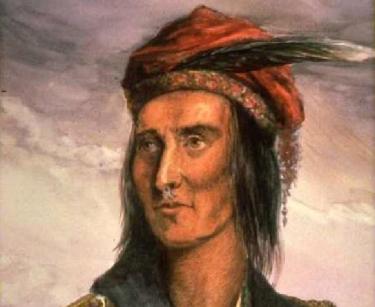
Native Americans played a major role in the War of 1812. Tribes were aligned with both sides of the conflict, although predominately tribes allied themselves with the British against the United States. The tribes fought along the frontier and along the Gulf Coast; tribal wars occurred alongside battles of the War of 1812. Famous Native Americans included Tecumseh, a Shawnee leader who organized a confederation of Native American tribes, known as Tecumseh’s Confederacy, to resist ongoing encroachment on their lands by European settlers. Tecumseh was killed at the Battle of the Thames and his Confederacy fell apart. Black Hawk was a Sauk chief who fought against American frontiersmen. After the War of 1812, Black Hawk organized a new confederacy, leading to the Black Hawk War of 1832.
What roles did African-Americans play in the War of 1812?
African Americans were not officially allowed to join the U.S. Army during the War of 1812, although they served extensively in the U.S. Navy. Approximately one-quarter of the U.S. sailors at the Battle of Lake Erie were African American. Roughly 350 men of the “Battalion of Free Men of Color” fought at the Battle of New Orleans.
A company of mostly escaped slaves served with the British in Canada, participating in the Battle of Queenston Heights and the Siege of Fort Erie.
During the Royal Navy’s blockade of the Atlantic seaboard, roughly 4,000 slaves escaped onto British ships, where they were welcomed and freed. Many of them joined the British military, participating in the Battle of Bladensburg and the burning of Washington, D.C.
How many people fought in the War of 1812?
Only 7,000 men served in the United States military when the war broke out. By the end of the war, more than 35,000 American regulars and 458,000 militia—though many of these were only mustered in for local defense—were serving on land and sea.
The global British regular military was comprised of 243,885 soldiers in 1812. By war’s end, more than 58,000 regulars, 4,000 militia, and 10,000 Native Americans would join the battle for North America.
How many people died in the War of 1812?
Roughly 15,000 Americans died as a result of the War of 1812. Roughly 8,600 British and Canadian soldiers died from battle or disease. The losses among Native American tribes are not known.
What were the major battles of the War of 1812?
The War of 1812 was shaped by battles on land and sea.

The capture of Detroit (August 16, 1812) – Only weeks after the war began, American General William Hull surrendered Detroit, along with a sizable army, without resistance to a smaller British force.
The capture of the HMS Java, HMS Guerriere, and HMS Macedonian (August-December 1812) – The new US frigates Constitution and United States started the war with a bang, performing well in a series of Atlantic engagements that boosted American morale after a disappointing beginning on land.
The Battle of Queenston Heights (October 13, 1812) – In a dramatic battle, British and Canadian troops turned back an American incursion into Canada. British General Isaac Brock was killed.
The Battle of York (April 27, 1813) – American forces burned York, the capital of Upper Canada, after winning a hard-fought land battle.
The Battle of Lake Erie (September 10, 1813) – Oliver Hazard Perry won fame for his heroic deeds in this victory, which secured Lake Erie for the rest of the war and paved the way for the liberation of Detroit.
The Battle of the Thames, Ontario (October 5, 1813) – William Henry Harrison crushed a combined force of British and Native Americans in this battle, killing the Shawnee leader Tecumseh and thus removing the most dangerous threat to American settlers in the northwest.
The Battle of Horseshoe Bend (March 27, 1814) – Andrew Jackson defeated the Red Stick Creeks and then forced the tribe to cede their claim to 23 million acres of what is now Alabama and Georgia.
The Battle of Bladensburg (August 24, 1814) – British regulars routed Maryland militia in this battle, opening the road to Washington, D.C., which they burned.
The Battle of Plattsburgh (September 11, 1814) – The British launched a poorly coordinated joint operation against the shipyard at Plattsburgh, but were decisively repulsed in one of the war’s largest naval engagements.
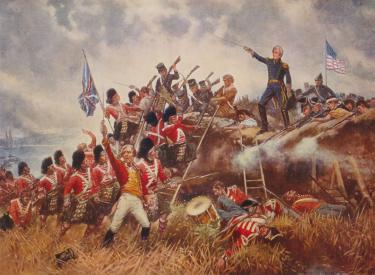
The Battle of North Point and the Defense of Fort McHenry (September 12-13, 1814) – After burning Washington, D.C., British forces advanced on Baltimore. Stubborn resistance at North Point and Fort McHenry saved the city, compelled the British to suspend their campaign, and inspired the American national anthem.
The Battles of Stoney Creek and Beaver Dams (June 6-24, 1813) – Another invasion of Canada was repulsed in these battles.
The Battle of Lundy’s Lane (July 25, 1814) – In one of the bloodiest battles of the war, one marked by extensive hand-to-hand fighting, the Americans were forced out of Canada for good.
The Battle of New Orleans (January 8, 1815) – Andrew Jackson inflicted over 2,000 casualties on attacking British troops while suffering 333 in the entire campaign. The battle became a touchstone of American pride, despite it occurring after the war had technically ended.
What kinds of weapons were used in the War of 1812?
The most widely used weapon in the War of 1812 was the smoothbore musket, which was carried by most of the infantrymen in the field. These had an effective battlefield range of 50-100 yards, necessitating close assaults and bayonet tactics be employed. There were also some units equipped with rifles, which were used primarily as light or specialized infantry.
Cannons were smoothbore as well, though they could shoot roughly 400 yards accurately. They were used with deadly, decisive effect on the battlefield.
Cavalrymen generally carried pistols and sabers and were used to outmaneuver or charge enemy formations.
How advanced was medicine during the War of 1812?
Disease was the primary cause of death during the War of 1812, not battlefield wounds. When men were wounded, they had little to look forward to in the hospital. Although sanitation was recognized as being medically important, advancements such as anesthesia and ambulatory care were still decades away. A British surgeon (who, along with one assistant, would generally be responsible for 1,000 men) remembered this:
“There is hardly on the face of the earth a less enviable situation than that of an Army Surgeon after a battle-worn out and fatigued in body and mind, surrounded by suffering, pain, and misery, much of which he knows it is not in his power to heal…. I never underwent such fatigue as I did the first week at Butler's Barracks. The weather was intensely hot, the flies in myriads, and lighting on the wounds, deposited their eggs, so that maggots were bred in a few hours.” – Tiger Dunlop, 89th Regiment of Foot

Were there any significant technological advancements during the War of 1812?
The War of 1812 was fought in the midst of the Industrial Revolution, in which a variety of technological advancements came together to forever change the way humans lived and worked.
Steamships and steam-powered railroad engines came into profitable use for the first time during the war years. While they had little effect on the North American conflict, these steam machines would become the technological standard in the decades to come.
Machines made with interchangeable parts became more common during the War of 1812, although the practice was not yet applied to military manufacturing. For the common soldier, the most significant advancement may well have been improved food storage through airtight packaging.
What were the political effects of the War of 1812?
Internationally, the war helped codify a fair standing between the United States, Britain, and Canada. This led to an era of mutually beneficial trade and diplomatic partnership.
Domestically, the war exacerbated tensions between northern industrialists and southern planters. Industrialists were reluctant to go to war with Britain, which was then the worldwide model of the Industrial Revolution. Southerners, on the other hand, were quick to remember the French assistance that had helped win the southern campaigns of the American Revolution as well as the ideological similarities between the two revolutionary nations. The American public generally viewed the outcome of the war favorably, causing the anti-war Federalist Party to fade from national prominence.
What were the economic effects of the War of 1812?
In the early years of the 19th century, the United States was a rapidly expanding commercial power. Many historians cite this growth as a key factor in Britain’s desire to contain American expansion. The war helped to secure America’s unfettered access to the sea, which played a large role in a post-war economic boom.
The prosecution of the war cost the United States government 105 million dollars, which equates to roughly 1.5 billion dollars in 2014. The strain of raising this money drove legislators to charter the Second National Bank, taking another step towards centralization.
Who won the War of 1812?
The peace terms that ended the war were those of status quo ante bellum, “the state of things as they were before the war.” So, while the War of 1812 was legally a tie—a wash—in terms of territorial acquisitions, historians now look at its long term effects to judge who won.
The Americans declared war (for the first time in their nation’s history) to stop British impressment, reopen the trade lanes with France, remove British support from Native American tribes, and to secure their territorial honor and integrity in the face of their old rulers. All four of these goals were achieved by the time peace broke out, although some British measures were scheduled to be repealed before the war had even begun. By establishing a respected footing with Britain and Canada, the United States also experienced a commercial boom in the years after the war. The overall result of the war was probably positive for the nation as a whole.
The British gained little to nothing from the war, save for an honorable friendship with the United States. Valuable resources were diverted from the battlefields of Europe for the War of 1812, which brought no land or treasure to the crown. The British also lost their Native American lodgment against United States expansion, further unleashing the growth of a major global trade competitor. However, the British did ultimately defeat France in their long war while avoiding a fiasco in North America, which is a considerable victory in the context of the global conflict they waged.
Many Native American tribes fought against the United States in the Northwest, united as a Confederacy led by a Shawnee man named Tecumseh. Many of these tribes had allied with the British during the Revolutionary War as well. The Creek tribe in the Southwest battled settlers and soldiers throughout the War of 1812, eventually allying with a column of British regulars. In reaching peace through status quo antebellum, however, the Native Americans all lost their main request of a recognized nation in North America. British support also evaporated in the years after the war, further quickening the loss of Native lands.
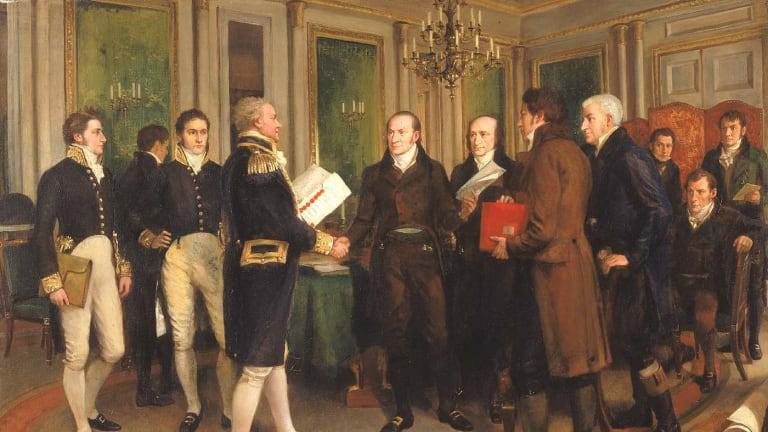
What are some of the best sources of information on the War of 1812?
The Smithsonian National Museum of American History is a treasure trove of information and artifacts, including the original Star-Spangled Banner.
There are many book sources for information on the War of 1812 including:
- The War of 1812: A Forgotten Conflict by Donald R. Hickey
- 1812: The War That Forged A Nation by Walter Borneman
- The War of 1812, Conflict and Deception: The British Attempt to Seize New Orleans and Nullify the Louisiana Purchase by Ronald J. Drez
- The Dawn’s Early Light by Walter Lord
- The Battle of New Orleans: Andrew Jackson and America’s First Military Victory by Robert Remini
Are any War of 1812 battlefields preserved?
Many battlefields from the War of 1812 are preserved in part or in full, but many are not. The United States federal government compiled a study in 2007 that identified development threats to many battlefields and described more than half as already being "destroyed or fragmented."
See the ways you can Take Action to preserve these battlefields.
Related Battles
1,105
128
123
440
853
878
200
250
62
2,034

